According to medical statistics, from 20 to 30% of the population of our planet have suffered from urticaria at least once in their lives. And those who have never suffered this illness themselves, to one degree or another, have at least a general idea of it. The idea that this is a childhood disease is absolutely wrong. Urticaria (Urticaria), a skin disease (mainly of an allergic nature), can occur in people of all ages. In our review article we will try to tell you what causes urticaria in adults, how to treat it, and also talk about publicly available preventive measures that will help prevent this disease.
External signs of the disease
What does urticaria look like in adults? The main external signs of the disease are the appearance on the body of numerous severely itchy redness, induration, inflammation, spots and blisters (fairly flat) of red or pink color. In appearance, the swelling is largely reminiscent of nettle burns (hence the common name). The development of the disease can occur very quickly: neoplasms on the body can appear within just a few minutes. The size of the swelling varies from a few millimeters to tens of centimeters. Over time, several small blisters may merge into one. External symptoms of urticaria appear on the legs, arms, back, abdomen and other parts of the body. It is especially dangerous for human health when swelling affects the respiratory tract (the person begins to choke) and the genitals (which leads to the inability to urinate).
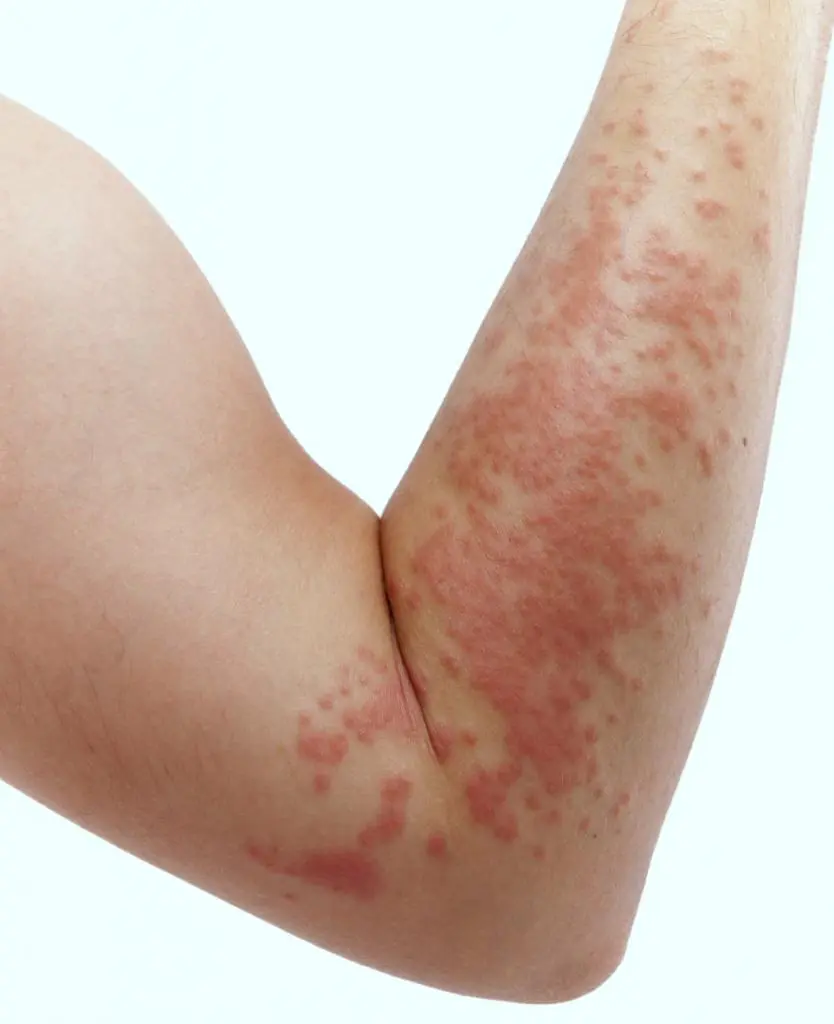
Minor signs
Associated symptoms of urticaria in adults include the sudden onset of muscle weakness, headache, nausea, chills, runny nose, diarrhea, fever, fever and cough. These secondary signs sometimes make it difficult to make a correct diagnosis, especially if the inflammation of the skin is not too obvious. It is easy to confuse the disease with, for example, ordinary food poisoning.
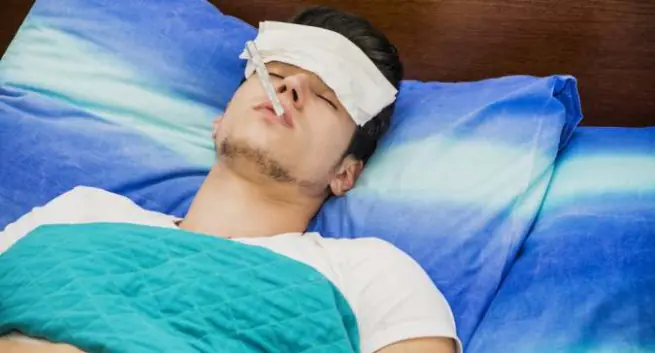
The mechanism of occurrence and development of urticaria
What causes urticaria in adults? The composition of human skin (and other connective tissues) includes mast cells that have capsules inside filled with histamine. When an allergic reaction occurs in the human body, this substance is released, enters the subcutaneous space through capillary vessels, accumulates and causes swelling and rash. That is, the mechanism of the disease is the rapid release of histamine from mast cells.
If the swelling can be stopped within 36 hours, then no damaged areas remain on the skin. Otherwise, damage to the walls of blood vessels begins.
Important! If, during the course of the disease, swelling spreads to the respiratory system, this can lead to the most severe consequences. In this case, emergency medical care is required!
Varieties
There are two main types of urticaria:
- Spicy. The duration of the disease usually does not exceed 5-6 weeks. As a rule, with proper and timely treatment, external manifestations can be eliminated within 24-36 hours.
- Chronic. Symptoms may last for several months (in particularly severe cases, even several years). According to experts, about 0.1% of humanity currently suffers from this disease.
Please note: one of the most dangerous types of acute urticaria is angioedema. It is accompanied by the rapid formation of compactions in the area of the eyes, lips and cheeks. The main danger is possible swelling of the larynx, which can lead to asphyxia (with all the ensuing consequences). To prevent death, urgent drug treatment is required.
Causes of allergic urticaria
The main cause of urticaria in adults is the body's reaction to a specific allergen. Moreover, a person may not even know what substance was the “provocateur” of the disease. The main triggers that cause a true allergic reaction in the body are food, medications, chemical compounds (including household detergents), pet hair, insect bites (bees, wasps, ticks, flies or cockroaches), pollen and, oddly enough, even ordinary household dust. In some cases (even with comprehensive examinations and numerous laboratory tests), the true cause of the disease cannot be determined.
One of the reasons for the appearance of urticaria in adults, no matter how paradoxical it may sound, is age. With its increase (especially after 40 years), the allergic reactions of the human body intensify. And, as a result, Urticaria can become a reaction to any everyday food product or habitual medicine.
On a note! If you find obvious signs of urticaria in an adult after sleep, then most likely the cause could be bites of the so-called bed tick. In addition to treating the disease itself, it is necessary to properly treat all bedding (mattress, pillows, blanket, etc.).
Non-allergic causes of the disease
In addition to allergies, the causes of urticaria in adults can be:
- various (especially chronic) diseases of the liver, kidneys, gastrointestinal tract, endocrine system, thyroid gland;
- pathogenic bacteria and viruses;
- inflammatory processes;
- stressful situations;
- intestinal parasites;
- the body's reaction to a sharp drop in ambient temperature or solar activity.
Diagnostics
An experienced specialist, when examining a patient and visually examining the skin rash, can find out what causes urticaria in adults. To make a correct diagnosis, a doctor (dermatologist, allergist or immunologist), first of all, will need detailed answers from the patient to the questions posed to him:
- When did external signs begin to appear?
- Was there an insect bite before this and, if so, what kind?
- What medications (and in what dosages) was the person taking before the incident?
- What did the patient eat during the day?
- What chronic diseases does the patient suffer from?
- Was there any contact with animals or chemicals?
As a rule, detailed answers to the above questions will be enough for an experienced specialist to make the correct diagnosis and prescribe effective treatment. The main thing is to find out the reason that caused the hives, because the next encounter with this allergen can lead to more serious consequences.
For chronic urticaria, laboratory tests are prescribed:
- general and biochemical blood test;
- test to identify problems with the immune system;
- skin tests;
- determination of the content of immunoglobulin E (its increased concentration indicates a predisposition to allergic reactions of the body, including urticaria);
- stool analysis to identify the presence of parasites in the body;
- checking the functioning of the kidneys, liver, thyroid gland and gastrointestinal tract.
Since sometimes even numerous laboratory tests do not allow us to identify the true cause of urticaria, in case of a chronic recurrent disease, a journal with records of all the events preceding the incident will help to identify the trigger. Subsequent analysis of systematized data greatly simplifies the search for a “provocateur.”
Drug treatment of acute urticaria
Various antihistamines have been successfully used to treat acute urticaria. Most of these medications are available without a prescription. And although experts do not recommend self-medication with medications, success in the fight against the disease largely depends on efficiency (often running to the pharmacy for medicine will take much less time than waiting for the local doctor to arrive).
The list of the most popular and very effective drugs taken for urticaria in adults: Diazolin, Cetrin (Cetirizine), Zyrtec, Fexofenadine, Erius. These medications help block the negative effects of histamine, reduce external rashes, and stop painful itching. In most cases, after the surgical use of these medications, a positive effect is observed. But further actions related to how and how to treat urticaria in adults should be done only after consultation with a specialist. It is he who will determine the duration of the course of treatment and give all the necessary recommendations.
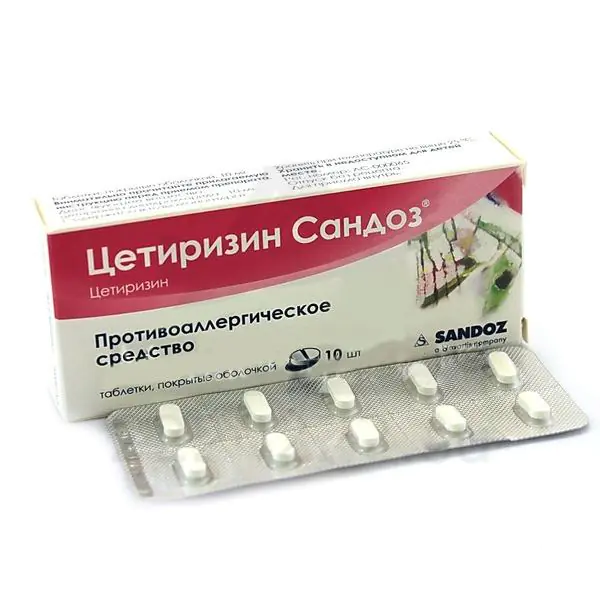
Treatment of chronic urticaria
When treating chronic urticaria, antihistamines (even in fairly large doses) cannot quickly reduce swelling and itching. How to treat urticaria in adults in this case? Specialists use special hormonal drugs – glucocorticosteroids – to treat chronic urticaria. The most well-known and frequently used medications of this group, produced in the form of tablets or injections: Prednisolone, Dexamethasone, Prednisone, Triamcinolone, Betamethasone.
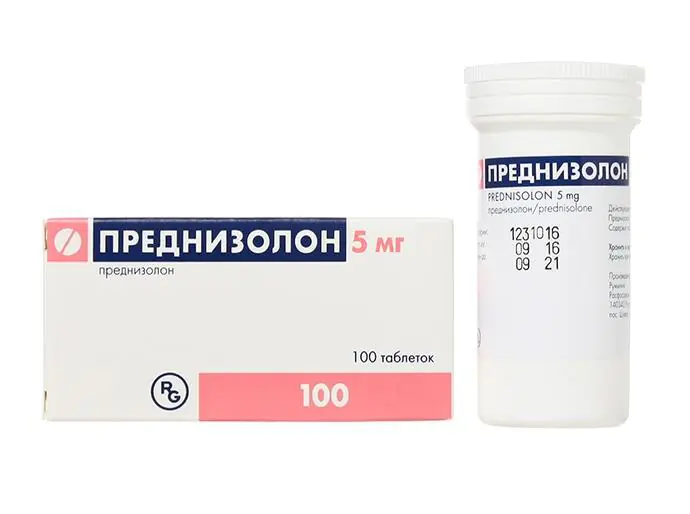
Using hormones on a regular basis is difficult because of the risk of serious side effects such as osteoporosis, glaucoma, diabetes, and a weakened immune system in general. Therefore, so-called monoclonal antibodies have recently been successfully used to treat severe cases of frequently recurring urticaria. The injectable drug "Omalizumab" ("Omalizumab" or "Xolair") blocks molecules of the immunoglobulin E protein, which plays a major role in the body's allergic reactions. A positive effect is observed even in the treatment of urticaria of unknown origin. A course of use of this drug leads not only to the elimination of symptoms, but also removes the causes of the chronic disease until it is completely cured.

First aid for urticaria in adults
Before being examined by a doctor and prescribing treatment methods, the patient can provide first aid to himself at home:
- First of all, we ventilate the room;
- we take any antiallergic drug (if it is available in the home medicine cabinet);
- take off clothes or put on looser clothes (made of soft materials that do not injure the skin);
- take a cool shower or bath;
- apply cold compresses to the most itchy areas;
- We go to bed (under no circumstances should you tolerate hives on your legs).
When is emergency medical care required?
Severe cases of allergic urticaria require immediate medical attention. The main signs for calling emergency help are:
- swelling of the lining of the mouth, tongue, lips, and throat;
- labored breathing;
- high body temperature (39°C or more);
- loss of consciousness or inadequacy in expressing thoughts;
- cardiopalmus;
- severe nausea and vomiting;
- cold and clammy skin.
If a patient with the symptoms described above is not provided with emergency medical care, this can lead to very serious consequences, even fatal.
Diet
Strict adherence to a certain diet plays an important role in the treatment of urticaria. First of all, foods that have the greatest effect on the production of histamine in the body’s mast cells should be excluded from the diet. These include spinach, chocolate, strawberries, fatty meats, tomatoes, yoghurts, fish and other seafood (shrimp, crabs, etc.). Also, during the treatment period, you should not drink alcoholic beverages, honey (and other sweets), eggs, coffee and strong tea.

What you can eat if you have hives: porridge (oatmeal or rice), boiled potatoes, fresh vegetables (cabbage, zucchini or cucumbers), boiled lean meat (turkey, chicken breast or beef), pears and apples.
Folk remedies in the fight against urticaria
The treatment of urticaria with folk remedies in adults must be approached with extreme caution. Any ingredient (or maybe several at once) may be a trigger for an allergic reaction, which the patient may not even be aware of, since he has not encountered it in everyday life. Before putting into practice the recipes of traditional healers, it is better to first consult with a specialist.
How to relieve itching with urticaria in an adult:
- Pour boiling water over a mixture of equal parts of string, chamomile and oak bark. Let it brew for 1-1.5 hours. Strain the broth and gently moisten the blisters with it.
- A paste of grated raw potatoes applied to inflamed areas helps to significantly reduce itching and swelling.
- A bath with the addition of an infusion of valerian leaves, celandine, St. John's wort and string to the water helps reduce pain symptoms.
Two simple and affordable recipes for treating urticaria in adults with folk remedies:
- Pour boiling water over mint leaves and leave for 30-40 minutes. Take orally three times a day before meals.
- Tea from walnut leaves, prepared at the rate of 2 teaspoons per 0.5 liter of water. A special feature of the preparation is the brewing time - at least 10 minutes.

Preventive measures
We briefly addressed the question of what causes urticaria in adults and how to treat it. However, taking fairly simple preventive measures will help significantly reduce the risk of this disease:
First of all, it is necessary to completely eliminate contact with specific allergens known to a person from personal experience or identified during clinical studies.
Getting rid of bad habits (for example, drinking alcohol and smoking) will not only have a positive effect on overall physical health, but will also strengthen the body's anti-allergic capabilities. Timely treatment of pathologies of the gastrointestinal tract, liver and kidneys will help reduce the likelihood of urticaria.
Both overheating and hypothermia of the body should be avoided. Therefore, sunbathing and walking in the cold need to be dosed wisely. Emotional stress not only weakens the nervous system, but can also be a trigger for the occurrence of hives. Therefore, naturally, if possible, they should be avoided or at least minimized.
Last (but not least) what you should pay attention to is your daily diet. Excluding highly allergenic foods from it significantly reduces the likelihood of developing the disease.
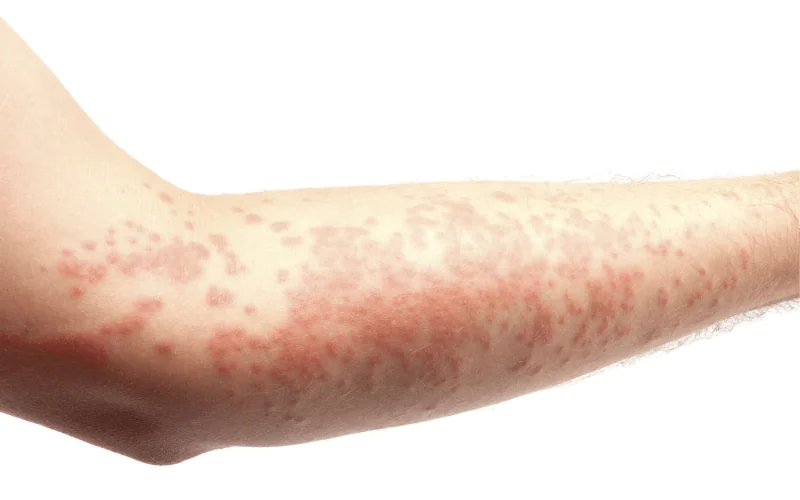
Urticaria is an allergic disease that manifests itself on the skin and mucous membranes in the form of blisters. Statistics show that women are more susceptible to this disease than men. The disease is common, a person faces this problem at least once in his life.
Causes of urticaria
According to doctors, the fact that urticaria is diagnosed in women twice as often as in men is explained by hormonal disorders that occur in the female body with age. The following factors can affect hormone levels:
- Pregnancy;
- Taking oral contraceptives;
- Menopause;
- Menstruation.
In most cases, doctors are unable to accurately determine the cause of a chronic allergic reaction. Therefore, you have to undergo a full examination and take a lot of tests. Chronic urticaria may appear for the following reasons:
- Infection entering the body;
- Decreased immunity;
- Allergy to specific foods;
- Physical effects on the skin;
- Presence of dermatitis;
- Diagnosis of diabetes mellitus of any group;
- Gastritis;
- Hepatitis;
- Leukemia;
- Herpes.
According to medical statistics, 15% of cases of urticaria occur precisely due to infection. Both viral and bacterial infections can cause rashes and skin irritation. It is important to immediately eliminate foci of inflammation, be it gastritis or caries. When immunity decreases, the body stops recognizing its cells and attacks them, which leads to autoimmune urticaria.
Physical factors provoking the disease
Doctors distinguish several types of physical urticaria, depending on the factors that provoked it:
- Sunlight. After exposure to sunlight on the skin of the patient (mostly women), a rash, redness and itching begins to appear. It is noteworthy that the rash is recorded only on those areas of the skin that are not covered by clothing.
- Cold. Unheated air or too cold water can also cause hives. In rare cases, symptoms of the disease are recorded when a person eats food that is too cold. Blisters appear around an area of skin that has been exposed to hypothermia.
- Water. Doctors call this type of urticaria aquagenic because it appears after a person comes into contact with water. It is noteworthy that there is usually no redness or blistering; the patient suffers from extremely severe itching.
- Strong vibrations. This type of urticaria is an occupational disease, as it occurs in people who, due to their occupation, are exposed to strong vibrations, for example, working with a jackhammer.
- Allergens. Hives can be caused by standard allergens: pollen during flowering, dust, animal hair. Symptoms completely disappear after a person protects himself from the allergen.
- A sharp increase in body temperature. Doctors call this type of urticaria cholinergic. It appears during a sharp increase in a person’s body temperature. This can happen not only due to illness, physical training, eating spicy or hot food, a surge of emotions - all this can cause a sharp rise in temperature. The blisters are small and pale, concentrated in the upper part of the patient's torso.
- Friction and compression. Hives may appear due to a too-tight belt, tight dress or shoes. It is noteworthy that physical pressure must continue for a long time for hives to appear. At the same time, the blisters here are oblong and do not appear on the skin at the same time as itching.
What does urticaria look like on the body?
The rash caused by urticaria is very similar to the rash caused by a nettle “burn.” Hence the name. Please note that inflammation and blisters may disappear and reappear. This course is called recurrent.
The rash is one of the main diagnostic symptoms of the described disease. Elements of the rash (blisters) can be round or oblong, small in size, slightly raised above the skin. Mostly pale pink in color. The skin around them is dark purple. The patient suffers from severe itching in the inflamed area.
The main feature of urticaria in adults is that it manifests itself quickly and then can also suddenly disappear. Itchy skin occurs due to irritated nerve endings. Much more of the neurotransmitter histamine enters the bloodstream than before. The level of itching (from tolerable to painful) varies precisely because of the amount of incoming substance.
Signs and symptoms
Essentially, urticaria is an allergic reaction exhibited by the body after contact with an allergen. Classic symptoms include:
- Redness of one or more areas of the skin;
- Blistering;
- Severe burning and itching in the area of inflammation;
- Temperature increase;
- Headache.
Depending on the course of the disease, urticaria can be acute or chronic. The acute form is recorded much more often than the chronic form.
Figure No. 1. Acute urticaria in a child.
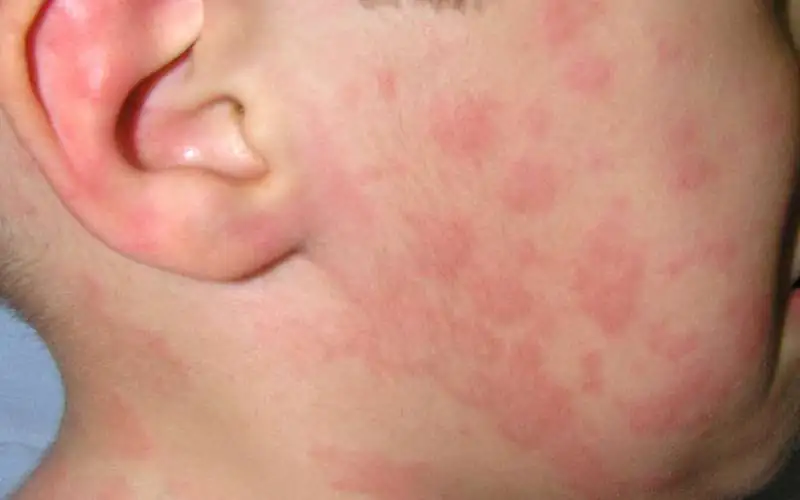
It can be diagnosed in young children and adolescents and can be a consequence of Quincke's edema. The diameter of the blisters in the acute form can reach one centimeter, and the rashes are concentrated not on individual areas of the skin, but throughout the body. The acute form of the disease can be cured in up to six weeks, but medical practice shows that this requires no more than a couple of days.
Chronic urticaria can be treated for longer than one and a half months; only adults from 20 to 40 years old are susceptible to this type. During treatment, periods of improvement and deterioration of the patient's condition may be observed. The rashes are light pink in color and change during exacerbations.
Course of the disease by period
The development of urticaria in the body occurs through immune and non-immune mechanisms. The first includes four more scenarios, based on four types of allergic reactions. According to the immune type, urticaria can appear on the skin and mucous membranes literally within a few minutes from the moment the allergen enters the patient’s body.
There are several mechanisms for the development of allergies, and they are all quite complex. It is important to know that swelling (rash) with urticaria occurs because the permeability of the capillaries increases and fluid accumulates around them. A substance such as histamine triggers the allergy mechanism. It is formed and accumulates in special cells - mast or mast cells. And the rupture of such a cell, and the release of histamine, leads to changes in the microcirculation and all the signs of allergies.
Figure No. 2. What does hives look like?
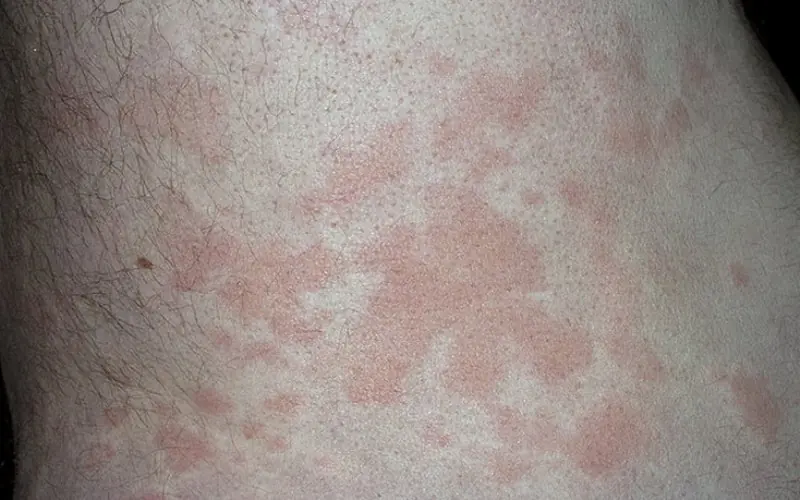
The patient feels itching, swelling on the skin, inflammation and blisters appear. All this is a consequence of the fact that the blood vessels have dilated, and the allergen has reached a critical point in the body. The non-immune course of the disease develops without major immune reactions. When an allergen enters the body, histamine and other biologically active substances are released. This form of urticaria is called chronic or idiopathic.
Establishing diagnosis
If you suspect urticaria, you need to make an appointment with a dermatologist or allergist. The specialist makes a diagnosis based on a patient interview and the manifestation of clinical signs of the disease. The doctor is able to determine what exactly the allergen is. For this, an in-depth examination is carried out. The patient will need to take allergy tests to identify the exact type of allergen. And a blood test for immunoglobulins (their level is increased with allergies).
Treatment
The most effective way to treat urticaria is to identify and eliminate the allergen that triggered the rash. If this was not possible, or when the disease is episodic, the doctor may prescribe antihistamines that will relieve the main symptoms. Moreover, during treatment you need to switch to a hypoallergenic diet and give up perfumes and cosmetics (in addition to hypoallergenic ones). Everything together will help prevent the appearance of new rashes and worsening the patient’s condition.
If classical treatment does not help, then the doctor may prescribe hormone-based medications. An equally effective addition to drug treatment would be immunomodulatory or immunosuppressive therapy.
Is hives contagious?
Many people worry about whether it is possible to catch hives from another person. The disease does not belong to the category of infectious, so the patient is not able to infect a healthy person, even if he is in very close contact with him. But you should be vigilant, because urticaria can become a symptom of infectious processes occurring in the body. Then infection from the infectious agent is possible.
Bathing for hives
Another popular question is whether it is possible to swim if you have hives. Taking a shower when you have hives is simply necessary, because it is important to maintain body hygiene. Without this, the disease may begin to progress and affect a larger area of skin. In order not to harm yourself, it is recommended to adhere to the following rules:
- The water should be warm, but not hot or cold. The ideal option would be 35 degrees. Hot or cold water can irritate the skin and trigger hives.
- Avoid using hard sponges, as well as shower gels and scrubs with abrasive particles. Personal hygiene products should not irritate the skin or damage it mechanically.
- Give preference to hypoallergenic personal care products, without fragrances or dyes; they are safer for the skin and will not cause allergies.
- You should not take a shower for longer than 15 minutes, and in case of an acute form of the disease, you should be in contact with water for no more than 5 minutes.
- After taking a shower, pat your skin dry with a natural fabric towel and apply medications or creams to the dermis.
If there are pustules on the skin, you need to shower very carefully. Contact with the affected area should be kept to a minimum, as should the time of the water procedure.
Who is most susceptible to the disease?
Today it is believed that women are more susceptible to urticaria than men. However, the manifestation of the disease in the latter is recorded quite often. So, men suffer from it between the ages of 30 and 50 years. The occurrence of rashes in old age is considered a very rare occurrence.
Artificial urticaria is recorded in people aged 20 to 30 years. It is called artificial because the rash and inflammation occurs as a result of physical friction against the skin, squeezing or scratching. Cholinergic urticaria, caused by heavy exercise, taking too hot a bath, or eating spicy foods, occurs in both men and women.
Figure No. 3. Cholinergic urticaria
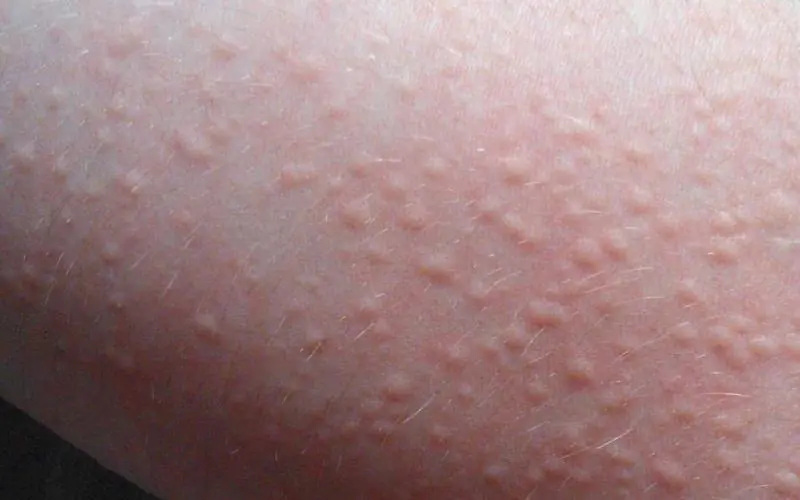
Moreover, the average age of patients is from 15 to 25 years.
Disease prevention
If the allergen that caused the rash has not been identified, then it is recommended to use the following preventive measures:
- Stop taking medications that could cause allergies;
- Minimize stress;
- Stop using tobacco and alcohol;
- Do not go to baths or saunas, which can cause overheating;
- Stop intense physical training;
- Adhere to a hypoallergenic diet, without seasonings and dyes;
- It is necessary to remove all animals from the apartment or house where the patient lives;
- Completely stop using feather pillows/blankets, completely switch to hypoallergenic cosmetics and hygiene products;
- Cure chronic diseases.
If the allergen has been identified, the patient must be completely isolated from it. The substance should not be contained in powders, household and hygiene products.
Consequences of the disease and complications
Many people who are faced with the problem of urticaria, even after undergoing tests, cannot determine the allergen that caused the rash. In such cases, idiopathic urticaria is diagnosed.
Figure No. 3. Idiopathic urticaria

In such cases, the disease can become chronic and unpleasant to remind of itself. A significant proportion of cases end in angioedema (Quincke's edema), that is, swelling of the subcutaneous tissue, asphyxia (if the edema affects the larynx) and suffocation. When an allergen is detected in specific products or medications, the patient has to completely stop using them, which causes inconvenience.
This approach may complicate the treatment of other diseases. For example, people often have allergies to drugs used for anesthesia in dentistry, then the doctor has to select other drugs that do not harm the patient’s health.
Pink-red, itchy blisters are a symptom of hives. The peculiarity of a skin rash is its sudden appearance on any part of the body. The boundaries of the lesion can be localized over a large area of the skin.
Why does hives appear?
The acute form, while the provoking cause remains intact, passes into the chronic stage. Treatment should primarily be aimed at the disease, the symptom of which is urticaria.
After recovery, the signs of the rash disappear without a trace, leaving no spots or scars. The body's predisposition to rashes of this kind must be taken into account when prescribing treatment. Diseases accompanied by rash and itching have different etiologies.
Peptic ulcer of the stomach and duodenum
Chronic diseases of the digestive system caused by bacterial infection (Helicobacter pyroli) can manifest as chronic urticaria (CU).
In addition to bacterial infection, the cause of inflammation of the mucous membrane of the stomach and duodenum with the symptom of urticaria can be:
- food allergies;
- drug allergies;
- endocrine;
- neuroregulatory.
The main method of treatment depends on the cause:
- elimination of the allergen;
- restoration of hormonal balance (for endocrine disorders);
- stabilization of central nervous system activity.
Compliance with a diet is a necessary condition for normalizing the secretory activity of the stomach. Medicinal plants that promote alkalization of gastric juice:
- St. John's wort;
- centaury;
- fennel;
- marshmallow root;
- liquorice root;
- flax-seed.
Use in the form of decoctions and infusions for 2-4 weeks.
Chronic gastritis
Pathogenic factors of hCG have the same signs as those of peptic ulcer and duodenum. In case of bacterial infection, antibiotics, diet and natural medicines are also prescribed.
Chronic enterocolitis
Absorption disorders in the large and small intestines due to worms, bacterial infection, and antibiotic use lead to the concentration of breakdown products in the tissues, including the epithelium, causing inflammation.
What is dysentery, watch in this video:
Parasitic infestations
Nausea, loss of energy, pain in the intestines and rashes with scabies are symptoms of infection with roundworms, cat fluke, and pinworms.
The cause of an allergic reaction is the toxic secretions of parasites.
A blood test shows an increased content of eosinophils (leukocytes), as the body’s reaction to a foreign protein. Testing for worm eggs completes the diagnostic picture. Treatment is aimed at destroying parasites.
Reaction to antibiotics
Manifestations of dysbacteriosis due to the destruction of intestinal microflora by bactericidal drugs are overcome with the help of colibacterin and bifidum. Herbal medicine helps restore all intestinal functions.
The following herbal remedies are used:
- alder cones;
- snake knotweed;
- Oak bark;
- strawberries;
- blueberry berries and leaves.
Infusions and decoctions are used for a long time, at least a month.
Shigella infection
Diet, biological products for microflora, herbal mixtures with cinquefoil roots, shepherd's purse herbs, plantain - methods of complex treatment of dysentery.
Chronic pancreatitis
Inflammation of the pancreas is a disease, one of the causes of which is diabetes mellitus. The basis of treatment for uncomplicated forms is a protein diet and herbal medicine.
The cause of urticaria in diabetes is a reaction to drugs used to treat diabetes.
The use of herbal remedies for CP is necessary to prevent gallstone disease. To normalize the flow of bile, use:
- celandine;
- anise fruit;
- corn silk;
- dandelion root.
Medicinal infusions containing sedatives, antispasmodics, tannins contribute to the remission of chronic pancreatitis.
Autoimmune diseases
Diseases of the thyroid gland provoke the development of chronic autoimmune urticaria. Unlike other types, it occurs in a more severe form and does not respond to antihistamines.
HC can also be caused by rheumatoid arthritis, lupus erythematosus, and celiac disease.
Rheumatoid arthritis
Morning stiffness and the appearance of papules (dense subcutaneous nodules) are symptoms of rheumatoid arthritis. The disease is considered incurable. Treatment is aimed at weakening the inflammatory process, relieving painful manifestations, and preventing complications.
lupus erythematosus
Fever and the appearance of a specific rash on the face can be a manifestation of lupus erythematosus. The skin disease tends to affect internal organs and is then called systemic lupus erythematosus.
Therapy for lupus erythematosus consists of prescribing steroids, B vitamins, and antifever medications.
Celiac disease
Congenital protein intolerance causes chronic inflammation of the small intestine. Main features:
- intolerance to dairy products;
- chronic diarrhea;
- stomach ache;
- anemia;
- thirst.
A nonspecific sign of celiac disease that may appear is atopic dermatitis (redness and dryness of the skin). This is an allergic reaction of a weakened immune system to any external irritant.
Dermatitis can be caused by dust, wool, or food.
A lifelong diet and medications that replace animal protein are combined with treatment of associated manifestations. An immunologist or allergist monitors the patient to prevent exacerbation of atopic dermatitis.
Urticaria without diagnosis
In half of the cases, it has still not been possible to determine the cause of the skin rash. Existing tests and methods do not provide an accurate answer about the mechanism of action on epithelial cells.
- bright pink blisters;
- persistent itching;
- proliferation and merging of rashes;
- spread throughout the body;
- secondary infection of scratches;
- insomnia;
- duration up to six months.
IC is classified into three subtypes:
In the first case, the mechanisms of self-regulation of the immune system are involved when the body's cells come into conflict with antigens. Pseudo-allergic IR implies an inadequate skin reaction to cold, ultraviolet radiation, infrared radiation, and liquids.
This video will tell you what rheumatoid arthritis is:
Contact idiopathic urticaria can occur from prolonged exposure of the skin to allergenic substances contained in tissues, skin, and artificial materials.
The main treatment for CIC is the elimination of any possible contact with allergens, starting with food ones.
Steroid medications and hormonal ointments are prescribed to relieve symptoms. External and internal use of a decoction of the string has a calming effect on inflammatory manifestations.
This symptom should not be ignored. The transition from the acute form to the chronic stage will require long-term treatment and is fraught with complications in the form of eczema or dermatitis.
As a preventative measure, it is recommended to follow a hypoallergenic diet and promptly consult a dermatologist and allergist.



